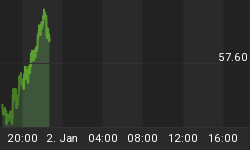The first chart is an SPX monthly chart that shows it's rare when both RSI and ULT (Ultimate Oscillator) are above 70. Also, SPX closed above it's upper Bollinger Band. Moreover, CCI and the Chaikin Oscillator are at high levels. Normally, when these levels are reached, a pullback or consolidation takes place.
The second chart is an SPX weekly chart that shows a close well above the upper Bollinger Band. NYSI (brown line) made a higher high for the first time since the cyclical bull market began four years ago. The NYMO 50-day MA is in a downtrend, which suggests SPX will be much lower within three months. The CPC 50-day MA is also in a downtrend, although from an all-time high reflecting sentiment is still somewhat market bullish.
A great deal of short-covering has driven the rally, since few expected SPX to rise much above 1,280. A short squeeze day was triggered the week before last, when SPX rose from 1,330 to 1,350. It seems, the market is attempting to trigger another short-squeeze day, although short-term technical indicators are generally severely overbought. The danger is the market may find itself overextended and exhausted. The bulk of third quarter earnings will be reported over the next two weeks. Also, there are several inflation-related reports next week. Given the current overbought condition, there may be selling on the (earnings) news.
Prior SPX movements indicate a pullback to around 1,350 next week. Also, intermediate-term technical indicators suggest a consolidation over the next few weeks. However, a larger pullback, perhaps in November, shouldn't be ruled out, since steep rallies often turn into steep pullbacks. Bond prices fell last week, while commodity prices, e.g. OIH and GLD, rose. The next FOMC meeting is October 25th. It's likely and expected the FOMC will pause again. Consequently, bond prices may rise or stabilize before the FOMC announcement. If oil and gold stabilize at current prices, oil and gold stocks may continue to rise or stabilize, because of discounting. So, there may be greater volatility in the stock market.


Charts courtesy of StockCharts.com
















